The diverse landscape, rich culture, and natural beauty of Nepal make it a world-renowned paradise for adventurers, nestled against the backdrop of giant snow-capped mountains. Notably, Nepal boasts the title of hosting the world's highest mountain, Everest (8,848.86m), and is privileged to have seven other towering peaks above eight thousand. Trekking enthusiasts find solace in the untouched natural beauty, unique Sherpa culture, and enduring traditional lifestyles that characterize this Himalayan realm. Indeed, Trekking in Nepal is more than just a journey; it's an immersive experience, where every trail unfurls captivating vistas of snow-capped peaks, verdant valleys, pristine lakes, shimmering Glaciers, and sweeping landscapes.
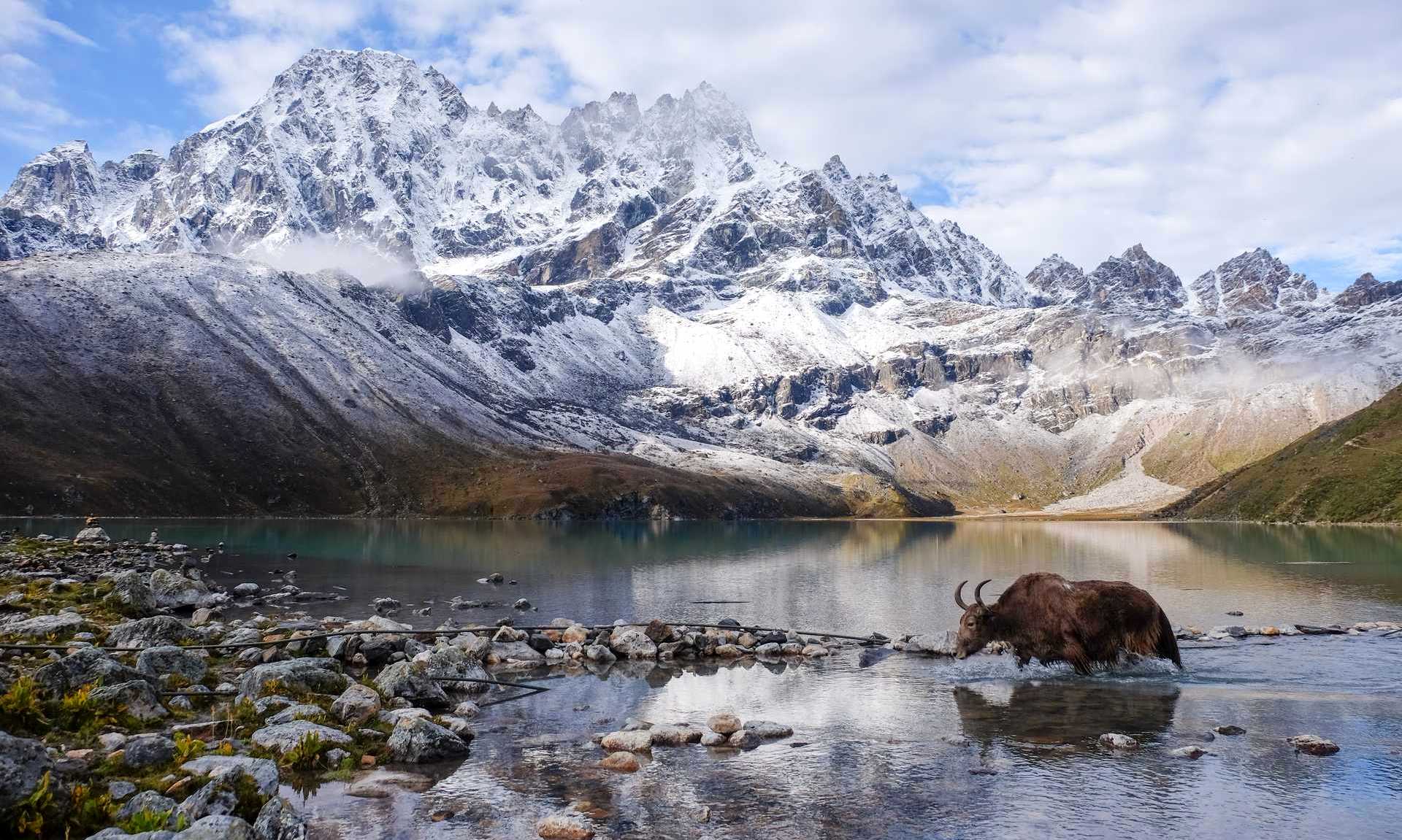
The Gokyo Valley stands as a gem amidst the vast Himalayan expanse. It is renowned for its spectacular Gokyo Lakes and the vantage point of Gokyo Ri, strategically positioned to the west of the illustrious Khumbu region. This region is primarily known for the iconic Everest Base Camp trek. As trekkers navigate the Everest region, they traverse the protected expanses of Sagarmatha National Park, discovering diverse trekking trails and hidden destinations. A popular choice among many is the combined Gokyo and Everest Base Camp Trek, offering a holistic Everest region experience. To explore the towering majesty of Everest and its surrounding panoramas is a dream harbored by many. Embarking on the Trek to Gokyo Ri in the Everest Region is a promise of adventure, filled with memories that last a lifetime.
How to reach Gokyo Lake?
Situated amidst the vast expanse of the Himalayas, Gokyo Lake is a serene destination that captivates every visitor. Reaching this pristine lake from Kathmandu offers several options, depending on your comfort, time, and sense of adventure. Here's how you can get there:
Classic Gokyo Lakes Trek: This is the most favored route by trekkers. Starting with a short flight from Kathmandu to Lukla, the journey progresses on foot. The trek takes you through Namche Bazaar, a bustling Sherpa village popular among Everest enthusiasts. Following a day of acclimatization here, the trek advances through Dole, Machhermo, culminating at Gokyo. Typically, this trek spans about a week from Lukla to Gokyo, though the duration might vary based on individual pace and acclimatization requirements.
Everest Base Camp via Gokyo Lakes Trek: For a more comprehensive experience, trekkers often combine the Everest Base Camp trek with the Gokyo Lakes trek. Post Namche Bazaar, this route diverts towards Dole, Machhermo, and Gokyo. Post Gokyo, trekkers navigate the Cho La pass, eventually merging with the base camp route at Lobuche.
Helicopter Tour: For those limited by time or seeking a novel experience, a helicopter tour to Gokyo Lake stands out. As you hover over the magnificent Himalayas, relish the panoramic views of towering peaks, sprawling glaciers, and picturesque valleys. The tour includes a brief halt near Gokyo Lake, offering you moments to take in the splendid beauty of the turquoise waters. This mode is especially suited for those keen on a quick and memorable escapade in the Gokyo region.
Horseback or Yak Riding: A less conventional but intriguing option is traversing the route on horseback or yak. While this is a rarer choice, it promises an entirely different experience. Organizing such a journey necessitates coordination with local guides or agencies and demands a certain level of physical fitness.
Navigating the high altitudes of the Himalayas requires serious consideration. Ensure that you are physically prepared, allow time for acclimatization to counter altitude sickness, and consider hiring a guide or associating with a trekking group for a safe and enriching journey.
Gokyo Valley
Nestled amidst the towering peaks of the Everest region, Gokyo Valley stands as one of Nepal's lesser-known treasures. Situated on the western flank of the iconic Mt. Everest, this valley is often overshadowed by the popularity of the Everest Base Camp trek but offers an equally mesmerizing experience, if not more.
The heart of the valley is the shimmering Gokyo Lakes, a series of five high-altitude freshwater lakes, regarded as the world's highest freshwater lake system. These turquoise jewels are set against the backdrop of majestic snow-clad mountains and vast glacial expanses, offering some of the most breathtaking panoramas in the Himalayas.
But it's not just about the natural beauty. The Gokyo Valley also embraces rich Sherpa culture, dotted with quaint villages, ancient monasteries, and prayer flags that whisper tales of spirituality and resilience against the rugged terrains. The trails meander through dense rhododendron forests, cross sparkling streams, and open up to alpine meadows that come alive with wildflowers in spring.
For trekkers looking for a unique Himalayan experience, the trek to Gokyo Valley promises serenity, unparalleled mountain views, and a deeper understanding of the region's cultural tapestry. In essence, Gokyo Valley is a pristine sanctuary in the Himalayas, waiting to be explored and revered.
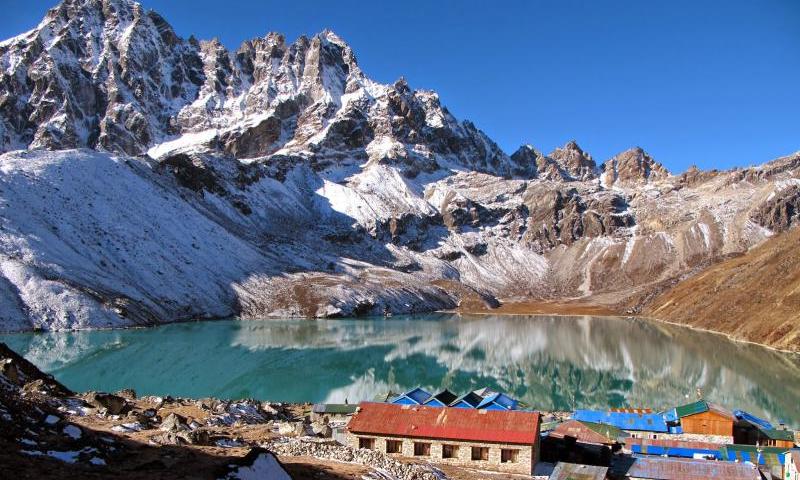
Major Highlights of Gokyo Lakes and Gokyo Valley
Gokyo Lakes
Gokyo Lakes, nestled deep within the confines of Sagarmatha National Park, offer trekkers an unparalleled spectacle on their journey through the Everest Region. Gaining recognition for their unparalleled beauty and ecological significance, these lakes, along with their associated wetlands covering an expansive 7,770 hectares, were christened as a Ramsar Site in 2007. They proudly wear the crown of being the world’s highest freshwater lake system, with their shimmering waters located at impressive altitudes ranging from 4,700m to 5,000m above sea level. These oligotrophic lakes serve as the birthplace of the mighty Dudhkoshi River, which, true to its name, cascades down the valley resembling flowing milk, adding another dimension of beauty to this already mesmerizing landscape.

Gokyo Lakes are an intricate mosaic of five main lakes. These are: Gokyo Cho or Dudh Pokhari, which sprawls over 42.9 ha; Thonak Cho, the most expansive of the lot covering 65.07 ha; Gyazumpa Cho with an area of 28 ha; Tanjung Cho measuring 16.95 ha; and Ngozumpa Cho covering 14.39 ha. Beyond these, the region cradles several other smaller lakes that contribute to the Gokyo system. More than just a natural wonder, the Gokyo Lakes hold religious significance for many, being a pilgrimage site for numerous Hindus and Buddhists. The lakeside is adorned with symbols of deep-rooted Buddhist culture, from intricately carved stone walls, chortens, and mani walls, to fluttering prayer flags. Nestled by its side is a quaint temple dedicated to the revered deities, Lord Shiva and Vishnu. The kaleidoscope of colors, spirituality, and stunning vistas make Gokyo Lakes a haven for photography enthusiasts, ensuring that every moment spent here etches into one's memory for a lifetime.
Gokyo Ri/Gokyo Peak
Gokyo Ri, often referred to as Gokyo Peak, stands tall and magnificent at an impressive elevation of 5,357m in the heart of the Khumbu region. This pinnacle is the crown jewel of the Gokyo Valley Trek. As trekkers meander their way towards Gokyo Ri, they are presented with the captivating sight of two pristine streams that gracefully flow at the northern extremity of the Gokyo Village. The ascent to the summit of Gokyo Ri from Gokyo Village typically takes about two hours, offering travelers a moderately challenging but immensely rewarding hike.
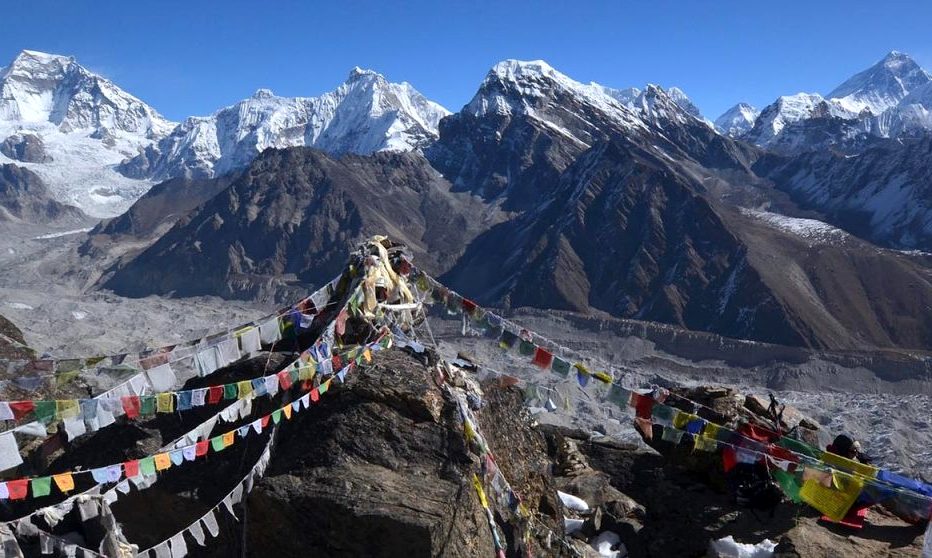
Nestled on the western flank of Ngozumpa Glacier, the largest glacier in Nepal, Gokyo Ri serves as an unparalleled vantage point in the Khumbu region. From its zenith, the eyes are treated to an expansive 360-degree panorama that boasts of the towering presence of four of the world's behemoth peaks, all rising above 8000m: Mt. Everest, Makalu, Lhotse, and Cho Oyu. But the spectacle doesn't end there; the shimmering waters of the Gokyo Lake system, the sprawling expanse of the Ngozumpa Glacier, and the undulating nearby hills contribute to the scenic tableau. The peak is especially enchanting during the golden hours of sunrise and sunset, as the first and last rays of the sun cast a magical glow, offering breathtaking vistas that remain etched in the memory of every visitor.
Sagarmatha National Park: Explore UNESCO Heritage Site
Sagarmatha National Park, a unique gem in the heart of Nepal, is a testament to the splendor of the Himalayas. Designated as a UNESCO World Heritage Site, this park pays homage to the tallest peak on Earth – Mount Everest, or as it's lovingly called in Nepali, Sagarmatha. Distinguished as the only national park set at such an astronomical altitude, its expansive boundaries encompass the serene Gokyo lakes, a haven for trekkers and nature enthusiasts alike.
The national park is a rich tapestry of biodiversity. A visit here is like flipping through the pages of a live encyclopedia of flora and fauna. Wander its trails, and you might catch a glimpse of elusive creatures such as the red panda, majestic Himalayan Thar, Ghoral, the intriguing Himalayan Black bear, and even the stealthy leopards. If the skies beckon your gaze, be prepared to spot exquisite bird species like the Blood Pheasant, yellow-billed chough, and the vibrant Himalayan Monal. Amidst the towering peaks, the park cradles a myriad of plant life, from dwarf shrubs to a carpet of lichens and mosses. Sagarmatha National Park isn't just a park; it's a living mosaic of nature's best offerings, all set against the backdrop of the grandest mountains in the world.
Gokyo Cho Village: The Highest settlement in the world
Gokyo Cho Village, nestled amidst the towering peaks of the Himalayas, holds the distinct title of being the highest settlement on Earth. A significant stop on the Gokyo Ri and Everest treks, this quaint village stands tall at a staggering 4,750m above sea level. As trekkers wind their way through the trail, the village appears as an oasis of Sherpa culture and hospitality.
When one sets foot in the village, the landscape is dotted with charming guest houses. These establishments, with their warm interiors and panoramic views of the Gokyo Valley, offer a cozy respite from the trek's rigors. While the village buzzes with activity during the trekking season, winter paints a different picture. Many inhabitants migrate to lower regions, such as Namche Bazaar, to escape the harsh cold. Regardless of the season, a visit to Gokyo Cho Village promises insights into the rich tapestry of local culture, spirituality, and the unparalleled warmth of the Sherpa community. This is not just a settlement; it's an embodiment of resilience and harmony at the top of the world.
Everest Base Camp from Gokyo Lakes
Everest Base Camp from Gokyo Lakes offers a trekking journey that takes you through the heart of the Himalayas, combining breathtaking landscapes with cultural experiences. Starting from the serene Gokyo Lakes, with a few days set aside for acclimatization, the path to Everest Base Camp beckons. As you proceed, the Yak Grazing Land emerges as an unforgettable sight, where these magnificent beasts graze freely against a backdrop of towering peaks.
Another major highlight is the challenging but rewarding trek over the Chola Pass, the highest pass in the Khumbu region. Traversing this pass requires navigating through glaciers and patches of melting ice, and it's an experience that becomes even more surreal with the fluttering prayer flags guiding the way. Further along the route, the beautiful Himalayan settlements provide an opportunity to immerse oneself in the local culture and way of life.
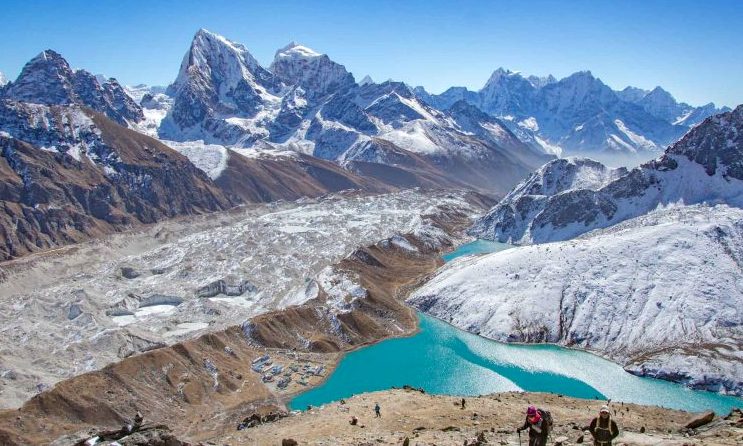
As you ascend higher and closer to the majestic Everest, the panoramic views become even more spellbinding. Snow-clad peaks, rolling landscapes, and the ever-changing play of light and shadow make every step worth the effort. The journey to Everest Base Camp from Gokyo is not just a trek; it's an experience that encapsulates the dreams and aspirations of countless adventurers from around the world.
More Highlights of Gokyo Lakes, the Highest Freshwater Lake System in The World
- One of the most picturesque Himalayan spots - Gokyo Valley
- Observe a series of six turquoise and glacier-fed lakes from the coast.
- The largest glacier in the Himalayas, Ngozumpa Glacier, is accessible by hiking.
- The highest point of Gokyo Valley - Gokyo Ri/Gokyo peak
- The Sagarmatha National Park
- Avoid the Everest crowds, but take in the variety of stunning vistas.
- To see breathtaking views of Everest, Lhotse, and Cho Oyu, climb Gokyo Ri (5,357 m).
- Explore the Khumjung, a Sherpa hamlet that is home to a "genuine" yeti skull.
- View the massive Ngozumpa Glacier from "Scoundrel's viewpoint," which is located close to the fifth lake. It is a wasteland of rock and ice.
Everest Region offers many exciting trekking and travel packages like Everest Base Camp via Gokyo Lake, Gokyo Lakes, Gokyo Ri Trek, and many more amazing trails.
Best time to visit Gokyo Lake
Gokyo Lake in Nepal can be visited throughout the year, with each season offering a unique experience. In spring (March to May), you'll encounter pleasant weather, clear skies, and blooming flowers. Summer (June to August) brings warmer temperatures and occasional rainfall. Autumn (September to November) is considered the best time to visit, with stable weather, clear skies, and stunning foliage. Winter (December to February) offers a serene atmosphere with cold temperatures and occasional snowfall. Each season has its own charm, so it's important to consider your preferences and the activities you plan to undertake when choosing the best time to visit Gokyo Lake.
Here is some general information about the weather for each season:
Spring (March to May)
- Weather: Spring is one of the best times to visit Gokyo Lake. The temperatures are moderate, and the weather is mostly stable. The days are sunny and warm, while nights can still be quite chilly.
- Scenery: This is the season when rhododendrons and other wildflowers bloom, painting the trails with a myriad of colors. The snow from winter starts to melt, making the paths clearer and less treacherous.
- Advantages: Clear views of the majestic Himalayan peaks, including Mt. Everest. The trails are bustling with trekkers, giving a vibrant feel to the journey.
- Considerations: This is a peak season, so teahouses and trails might be crowded.
Summer/Monsoon (June to August)
- Weather: Summer is also the monsoon season in Nepal. Expect heavy rainfall, especially in June and July. The temperatures are warmer, but the frequent rain might make the weather feel colder and damp.
- Scenery: The rain brings out the lush greenery of the region. Waterfalls and streams become lively and more picturesque.
- Advantages: Less crowded trails and teahouses. A good time for keen botanists as the vegetation is lush and green.
- Considerations: The rain can cause landslides and make trails slippery. There's a risk of leeches on lower elevations. Visibility might be reduced due to frequent rain and mist.
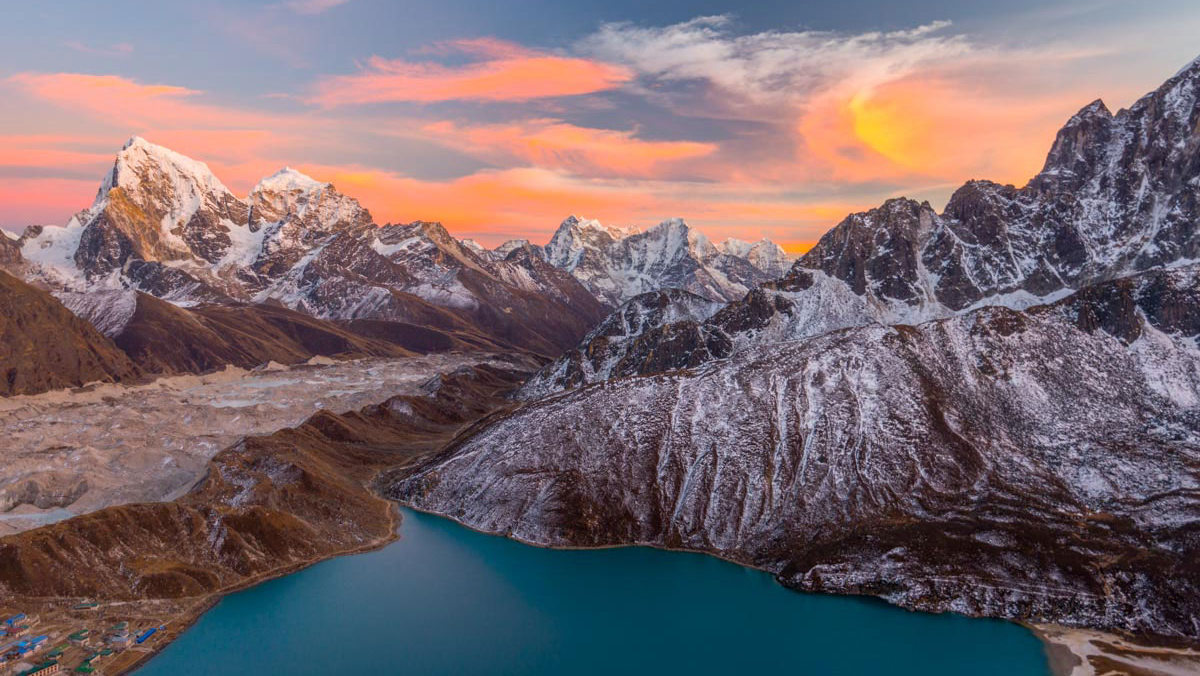
Autumn (September to November)
- Weather: Autumn is another favorite season for trekkers. The temperatures start to drop, especially in late October and November, but the weather is stable with clear skies.
- Scenery: After the monsoon, the atmosphere clears up, offering stunning views of the snow-capped mountains. The forests showcase a vibrant mix of reds, oranges, and yellows.
- Advantages: Excellent visibility and dry trails make trekking pleasant. Popular festivals like Dashain and Tihar fall in this season, offering a cultural treat.
- Considerations: Like spring, this is a peak season. Thus, the trails and teahouses can be crowded.
Winter (December to February)
- Weather: Winter in the Gokyo region is cold, especially during January and February. Daytime temperatures are bearable, but nights and mornings can be freezing.
- Scenery: The region gets a blanket of snow, turning Gokyo Lake and the surrounding area into a winter wonderland. The skies remain clear, offering crisp views of the mountains.
- Advantages: Fewer trekkers on the trail mean a serene trekking experience. It's also a great time for photographers looking to capture snow-covered landscapes.
- Considerations: Heavy snowfall might block some trails. Proper gear and clothing are essential to stay warm. Some teahouses might be closed due to the extreme cold.
It's important to note that temperatures can vary based on the altitude and specific weather conditions during your visit. Therefore, it's advisable to check the current weather forecast and consult with local guides for the most accurate and up-to-date information before planning your trip to Gokyo Lake.
Why Gokyo Lakes Should Be on Your Bucket List
If you need any further information, please contact us by email: at [email protected], Phone: +977- 985 100 5129 (WhatsApp)